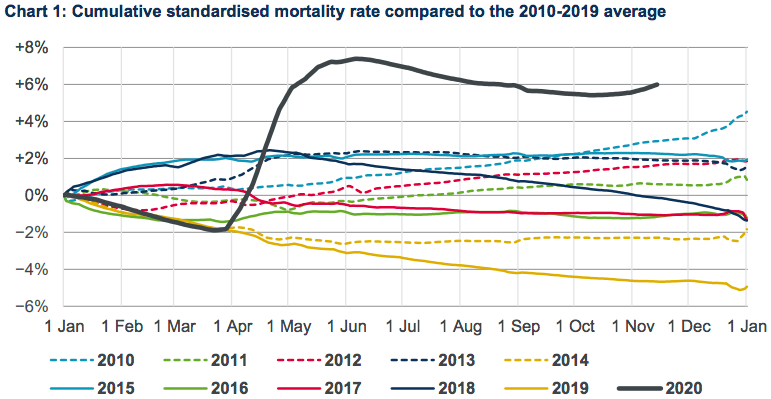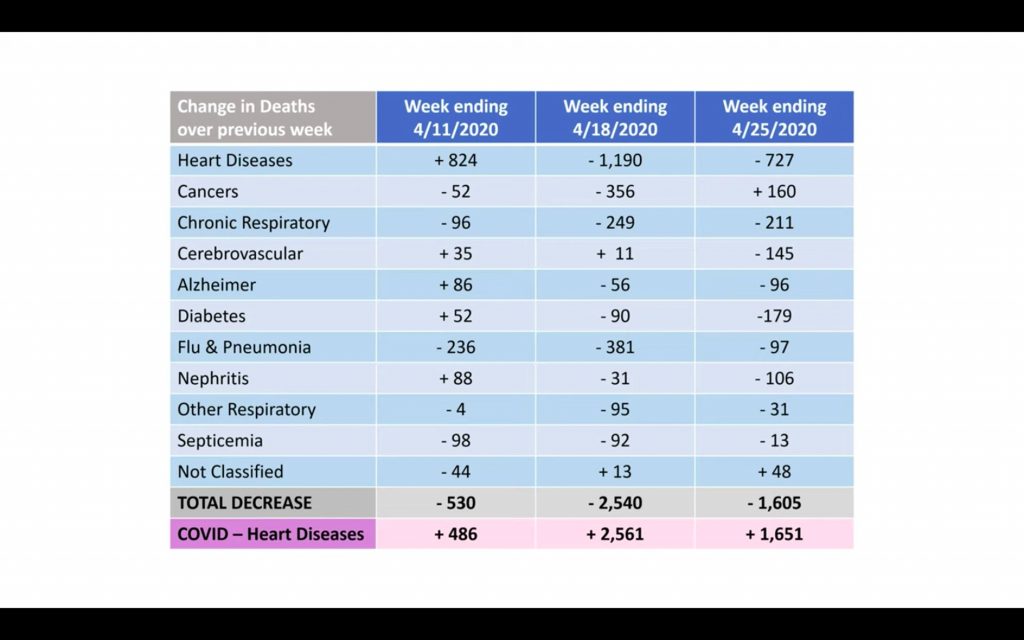Are We Over-Counting Excess Deaths?
Fri 11:08 am +01:00, 27 Nov 2020
How many more have died in England and Wales in 2020 than in a normal year? To calculate the number of “excess” deaths, most of us follow the ONS in comparing this year’s figure with the average of the previous five years. But is this a fair representation of how many deaths are above what would be expected? Not when the population is ageing, explains Ross Clark in the Spectator.
Not only is the population of England and Wales growing; it is also ageing. The population of over-70s, for example, has grown over the past decade by an average of 2% a year. Therefore, year on year, we should expect deaths to rise – simply comparing this year’s mortality rate with the five-year average does not give us a like for like picture. A more enlightening view is provided by the Institute and Faculty of Actuaries, which publishes a weekly ‘mortality monitor’ in which it compares this year’s mortality rate with last year’s, adjusting for the change in population profile over the past 12 months.
Its analysis shows that deaths in week 46 were 1,442 — or 13% — higher than they would have been had 2020 had the same mortality rate as last year. Compare it with the standardised mortality rate for the years 2015 to 2019, on the other hand, and excess deaths for week 46 of 2020 fall to 1,388.
By this way of counting 2020 was only running at 6% above average mortality by mid-November (see graph above). Many of those extra deaths are the result of lockdown, not the virus, of course.
Worth reading in full.
Stop Press: An article in the Johns Hopkins Newsletter published on November 22nd summarised the findings of Genevieve Briand, Assistant Program Director of the Applied Economics Master’s Degree Program at Hopkins. She analysed all-cause mortality in the US in 2020, comparing the data to deaths in previous years, and found, to her surprise, that 2020 was less exceptional that it seemed at first blush.
After retrieving data on the CDC website, Briand compiled a graph representing percentages of total deaths per age category from early February to early September, which includes the period from before COVID-19 was detected in the U.S. to after infection rates soared.
Surprisingly, the deaths of older people stayed the same before and after COVID-19. Since COVID-19 mainly affects the elderly, experts expected an increase in the percentage of deaths in older age groups. However, this increase is not seen from the CDC data. In fact, the percentages of deaths among all age groups remain relatively the same.
“The reason we have a higher number of reported COVID-19 deaths among older individuals than younger individuals is simply because every day in the U.S. older individuals die in higher numbers than younger individuals,” Briand said.
Briand also noted that 50,000 to 70,000 deaths are seen both before and after COVID-19, indicating that this number of deaths was normal long before COVID-19 emerged. Therefore, according to Briand, not only has COVID-19 had no effect on the percentage of deaths of older people, but it has also not increased the total number of deaths.
These data analyses suggest that in contrast to most people’s assumptions, the number of deaths by COVID-19 is not alarming. In fact, it has relatively no effect on deaths in the United States.
But how is this possible? After all, hasn’t COVID-19 killed over 250,000 Americans this year?
When Briand looked at the 2020 data during that seasonal period, COVID-19-related deaths exceeded deaths from heart diseases. This was highly unusual since heart disease has always prevailed as the leading cause of deaths. However, when taking a closer look at the death numbers, she noted something strange. As Briand compared the number of deaths per cause during that period in 2020 to 2018, she noticed that instead of the expected drastic increase across all causes, there was a significant decrease in deaths due to heart disease. Even more surprising this sudden decline in deaths is observed for all other causes.
This trend is completely contrary to the pattern observed in all previous years. Interestingly, as depicted in the table below, the total decrease in deaths by other causes almost exactly equals the increase in deaths by COVID-19. This suggests, according to Briand, that the COVID-19 death toll is misleading. Briand believes that deaths due to heart diseases, respiratory diseases, influenza and pneumonia may instead be recategorized as being due to COVID-19.

Needless to say, the article no longer appears on the website of the Johns Hopkins Newsletter – far too heretical. But you can read a cached version here. We’ve made a copy in case the enforcers of Covid orthodoxy remove that too. If it’s gone by the time you read this, email us and we’ll send it to you.
By
https://lockdownsceptics.org/










